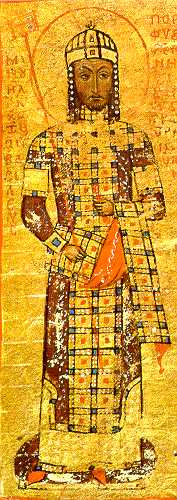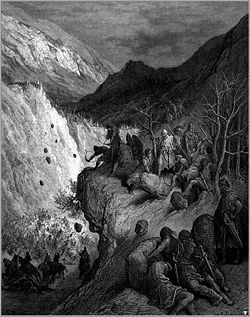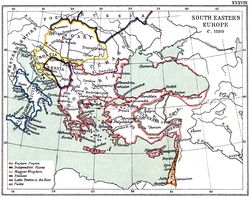Battle of Myriokephalon
| Battle of Myriokephalon | |||||||
|---|---|---|---|---|---|---|---|
| Part of the Byzantine-Seljuk wars | |||||||
 Emperor Manuel I Komnenos |
|||||||
|
|||||||
| Belligerents | |||||||
| Sultanate of Rum | |||||||
| Commanders and leaders | |||||||
| Manuel I Komnenos | Kilij Arslan II | ||||||
| Strength | |||||||
| 25,000 men[3] 30,000 - 40,000 men.[4] | Unknown | ||||||
| Casualties and losses | |||||||
| Unknown*[5] | Unknown.[6] | ||||||
| *Possibly heavy[7][8] | |||||||
|
|||||
The Battle of Myriokephalon, also known as the Myriocephalum, or Miryakefalon Savaşı in Turkish, was a battle between the Byzantine Empire and the Seljuk Turks in Phrygia on September 17, 1176. It was a serious reverse for the Byzantine forces and was to be the final, unsuccessful effort by the Byzantines to recover the interior of Anatolia from the Seljuk Turks.
Contents |
Background
Manuel I Komnenos, the Byzantine Emperor, had been at peace with Kilij Arslan II, the Seljuk Turkish Sultan of Rûm, during the 1170s. It was a fragile peace, however, as the Seljuks wanted to push westwards, further into Asia Minor, while the Byzantines wanted to push eastwards to recover territory they had lost since the Battle of Manzikert one hundred years earlier. Manuel was able to recover Cilicia and impose his authority over the Crusader Principality of Antioch, and was also aided by the fact that the emir of Aleppo, Nur ad-Din Zangi, died in 1174; his successor Saladin was concerned more with Egypt than the territory bordering the Empire, so the Seljuks were left without a strong ally. In 1175, the peace fell apart when Kilij Arslan refused to return territory he had conquered from their common enemy the Danishmends.
March
Manuel gathered an army, supposedly so large that it spread across ten miles, and marched towards the border with the Seljuks via Laodicea, Chonae, and Antioch. Arslan tried to negotiate but Manuel was convinced of his superiority and rejected a new peace.[9] He sent part of the army under Andronikos Vatatzes towards Amasia while his larger force marched towards the Seljuk capital at Iconium (Konya). Both routes were through heavily wooded regions, where the Turks could easily hide and set up ambushes; the army moving towards Amasia was destroyed in one such ambush. The Turks later displayed Andronikos's head, impaled on a lance, during the fighting at Myriokephalon.[10]
The Turks also destroyed crops and poisoned water supplies to make Manuel's march more difficult. Arslan harassed the Byzantine army in order to force it into the Meander valley, and specifically the mountain pass of Tzivritze near the fortress of Myriokephalon. Once at the pass Manuel decided to attack, despite the danger from further ambushes, and also despite the fact that he could have attempted to bring the Turks out of their positions to fight them on the nearby plain of Philomelion, the site of an earlier victory won by his grandfather Alexios. The lack of forage, and water for his troops, and the fact that dysentery had broken out in his army may have induced Manuel to decide to force the pass regardless of the danger of ambush.[11]
Battle
All sources agree that the Byzantine force was of exceptional size, estimates of its strength vary between 25,000 and 40,000 soldiers.[12][13] It included an allied contingent of Hungarians sent by Manuel's kinsman Béla III of Hungary and a tributary force supplied by the Principality of Antioch.[14] No estimate of Seljuk numbers has been possible. The Byzantine army was divided into a number of divisions, which entered the pass in the following order: a vanguard, largely of infantry (the other divisions being composed of a mix of infantry and cavalry); the main division (of eastern and western Tagmata); then the right wing (largely composed of Antiochenes and other Westerners), led by Baldwin of Antioch (Manuel's brother-in-law); the baggage and siege trains; the Byzantine left wing, led by Theodore Mavrozomes and John Kantakouzenos; the emperor and his picked troops; and finally the rear division under the experienced general Andronikos Kontostephanos.[15]

The Byzantine vanguard was the first to encounter Arslan's troops, and went through the pass with few casualties, as did the main division. Possibly the Turks had not yet fully deployed in their positions.[16] By the time the first two Byzantine divisions exited the far end of the pass, the rear was just about to enter; this allowed the Turks to close their trap on those divisions still within the pass. The Turkish attack, descending from the heights, fell especially heavily on the Byzantine right wing. This division seems to have quickly lost cohesion and been broken, soldiers fleeing one ambush often running into another. Heavy casualties were sustained by the right wing and its commander, Baldwin, was killed.[17] The Turks then concentrated their attacks on the baggage and siege trains, shooting down the draught animals and choking the roadway. The left wing division also suffered significant casualties and one of its leaders, John Kantakouzenos, was slain when fighting alone against a band of Seljuk soldiers.[18] The remaining Byzantine troops were panicked by the carnage in front of them and the realisation that the Turks had also begun to attack their rear. The sudden descent of a blinding dust-storm did nothing to improve the morale or organisation of the Byzantine forces, though it must have confused the Seljuk troops also. At this point, Manuel seems to have suffered a crisis of confidence and reputedly sat down, passively awaiting his fate and that of his army.[19] The emperor was eventually roused by his officers, re-established discipline and organised his forces into a defensive formation; when formed up, they pushed their way past the wreck of the baggage and out of the pass.[19] Debouching from the pass they re-joined the unscathed van and main divisions, commanded by John and Andronikos Angelos, Constantine Makrodoukas and Andronikos Lampardas. Whilst the rest of the army had been under attack in the pass the troops of the van and main divisions had constructed a fortified encampment. The rear division, under Andronikos Kontostephanos, arrived at the camp somewhat later than the emperor, having suffered few casualties.[20]
The night was spent in successfully repulsing further attacks by Seljuk mounted archers.[19] Choniates states that Manuel considered abandoning his troops but was shamed into staying by the scathing words of an anonymous soldier and the disapproval of a shocked Kontostephanos.[21] However, this would appear to be hyperbole on the historian's part as Manuel would have placed himself in much greater danger by flight than if he remained in the midst of his army. The following day, the Turks circled the camp firing arrows; Manuel ordered two counterattacks, led by John Angelos and Constantine Makrodoukas respectively, but there was no renewal of a general action.[22]
Outcome
Both sides, it appears, had suffered casualties, though their extent is difficult to quantify. As the Byzantine army moved back though the pass after the battle it was seen that the dead had been scalped and their genitals mutilated, "It was said that the Turks took these measures so that the circumcised could not be distinguished from the uncircumcised and the victory therefore disputed and contested since many had fallen on both sides."[23] Most importantly Manuel's siege equipment had been captured and destroyed. The Byzantines, without any means of attacking Iconium, were now no longer in a position to continue the campaign. Also the Seljuk Sultan was keen for peace to be restored as soon as possible; he sent an envoy named Gabras, together with gifts of a Nisaean warhorse and a sword, to Manuel in order to negotiate a truce.[24] As a result of these negotiations, the Byzantine army was to be allowed to retreat unmolested on condition that Manuel destroy his forts and evacuate the garrisons at Dorylaeum and Sublaeum on the Byzantine-Seljuk border.[25] However, despite Kilij Arslan's protestations of good faith, the retreat of the Byzantine army was harassed by the attacks of Turcoman tribesmen (over whom Kilij Arslan probably had very little control). This, taken with an earlier failure by the sultan to keep his side of a treaty signed in 1162, gave Manuel an excuse to avoid observing the terms of this new arrangement in their entirety. He therefore demolished the fortifications of the less important fortress of Sublaeum and left Dorylaeum intact.[26]

Manuel himself compared his defeat to that of Manzikert, sending a message to Constantinople ahead of his army likening his fate to that of Romanos Diogenes. However, in the same message he: "Then extolled the treaties made with the sultan, boasting that these had been concluded beneath his own banner which had waved in the wind in view of the enemy's front line so that trembling and fear fell upon them."[27] It must be acknowledged that it was the sultan who initiated peace proposals by sending an envoy to Manuel and not the reverse. It is reasonable to conclude that Kilij Arslan, though negotiating from a position of strength, did not consider that his forces were capable of destroying the Byzantine army. A possible reason for Kilij Arslan's reluctance to renew the battle is that a large proportion of his irregular troops may have been far more interested in securing the plunder they had taken than in continuing the fight, thus leaving his army seriously weakened.[28] Myriokephalon, although a significant defeat for the Byzantines, did not materially affect the capabilities of the Byzantine army. This is underlined by the notable victory the Byzantines won over the Seljuks at Hyelion and Leimocheir on the Meander River the following year.[29] Manuel continued to meet the Seljuks in smaller battles with some success, and concluded a probably advantageous peace with Kilij Arslan in 1179.[30] However, like Manzikert, Myriokephalon was a pivotal event and following it the balance between the two powers in Anatolia gradually began to shift, for Manuel never again launched a strategically offensive campaign against the Turks and remained on the defensive.
Myriokephalon had more of a psychological impact than a military impact, as it proved that the Empire could not destroy Seljuk power in central Anatolia despite the advances made during Manuel's reign. Essentially, the problem was that Manuel had allowed himself to be distracted by a series of adventures in Italy and Egypt, instead of dealing with the more pressing issue of the Turks. This had given the Sultan many years in which to eliminate his rivals, enabling him to build up a force capable of facing the Byzantine army in the field. Without the years required to build up this Seljuk force, the battle could never have even taken place. Furthermore, during the campaign, Manuel made several serious tactical errors, such as failing to properly scout out the route ahead and failing to take the advice of his senior officers. These failings caused him to lead his forces straight into a classic ambush.
After Manuel's death, the empire drifted into anarchy, and it was never again in a position to mount a major offensive in the east. Thus, ultimately the defeat marked the end of Byzantine attempts to recover the Anatolian plateau, which was now lost to the empire forever.
See also
- Komnenian army
References
- ↑ Treadgold1997, p. 635.
- ↑ The battle was decisive in that it saved the Seljuk Sultanate but the military balance between the two belligerents was not greatly affected by its outcome. The bulk of Byzantine Asia Minor was retained for more than a century after the battle. Magdalino 1993, p. 99. "Whatever he [Manuel] said in the moment of defeat, it was not a disaster on the scale of Manzikert… Even Choniates admits that the frontier in Asia Minor did not collapse."
- ↑ Haldon 2001, p. 198.
- ↑ Birkenmeir, p. 180.
- ↑ Alongside indications of heavy Byzantine losses, other sources (see the body of text) emphasise that most of the losses fell on only two of the six divisions of the Byzantine army (and also on the baggage and siege train). Choniates 1984, p. 107, the main primary source for the battle, also states that when the Byzantines moved back through the pass after the battle they found that the heads and genitals (to disguise Moslem circumcision) of the dead had been mutilated to prevent them being identified. This strongly suggests that Seljuk casualties had been significant.
- ↑ Choniates 1984, p. 107.
- ↑ Magdalino 1993, p. 98. "The defeat which it suffered in the narrows of Tzibritze, a day's march from Konya, near the ruined fort of Myriokephalon, was correspondingly humiliating. The Turks made great slaughter, took great quantity of booty, and came close to capturing the Emperor himself who gratefully accepted the sultan's offer of a truce in return of demolishing Dorylaion and Sublaion."
- ↑ Bradbury 2004, p. 176. "With Manuel were Hungarian allies and his brother-in-law Baldwin of Antioch. Baldwin charged but was killed. The Byzantines suffered heavy losses. Kilij Arslan offered terms and the Byzantines were allowed to withdraw."
- ↑ Angold 1997, p. 192.
- ↑ Choniates 1984, p. 103.
- ↑ Choniates 1984, p. 101; Haldon 2001, pp. 141–142.
- ↑ name="Haldon198">Haldon 2001, p. 198
- ↑ Birkenmeir, p. 180.
- ↑ Markó, László (2000), Great Honours of the Hungarian State, Budapest: Magyar Könyvklub, ISBN 9635470851. The Hungarian troops were commanded by Ompud, Count Palatine and Leustak, Voivode of Transylvania.
- ↑ Choniates 1984, p. 102; Haldon 2001, p. 142.
- ↑ Haldon 2001, p. 142.
- ↑ Choniates 1984, p. 102; Haldon 2001, pp. 142–143.
- ↑ Choniates 1984, p. 104.
- ↑ 19.0 19.1 19.2 Haldon 2001, p. 143.
- ↑ Choniates 1984, p. 105.
- ↑ Choniates 1984, pp. 105–106. Manuel may have had the fate of Romanos Diogenes in mind and have had some apprehension of being captured. His situation was, however, very different to that of Diogenes. Unlike the case of the earlier emperor, Manuel's troops had not dispersed from the battlefield but had drawn together following their defeat and were still capable of defending themselves.
- ↑ Choniates 1984, p. 106. It is notable that the two generals leading the counterattacks commanded units which had suffered negligible losses the previous day. It is probable that the Byzantine counter-attacks achieved little because, once in open country, the Seljuks were reluctant to come to close combat with the more heavily armoured Byzantine cavalry, and the Byzantines were unwilling to pursue too far for fear of further ambushes.
- ↑ Choniates 1984, p. 107. Presumably the scalping took place because the Turks wore their hair in a distinctive style.
- ↑ Choniates 1984, p. 107. The "Gabras" who acted as emissary was possibly Iktiyar ad-Din Hasan ibn Gabras, who was Kilij Arslan's vizier and was of Greek origins. He was a member of the Gabras family that had ruled Trebizond earlier in the 12th century. There were a number of prominent Greek aristocrats in Seljuk employ, including Manuel's first cousin John Tzelepes Komnenos.
- ↑ Angold 1997, pp. 192–193.
- ↑ Treadgold 1997, p. 649.
- ↑ Choniates 1984, p. 108.
- ↑ Finlay 1877, p. 195.
- ↑ Ironically, this battle was a reverse of Myriokephalon with a Seljuk army blundering into a classic ambush laid by the Byzantine general John Vatatzes.
- ↑ Angold 1997, p. 193; Magdalino 1993, pp. 99–100.
Further reading
Primary source
- Choniates, Niketas (1984), Historia, English translation: Magoulias, H. (O City of Byzantium: Annals of Niketas Choniates), Detroit, ISBN 0814317642
Secondary sources
- Angold, Michael (1997), The Byzantine Empire, 1025–1204, New York: Longman, ISBN 0582294681
- Bradbury, Jim (2004), The Routledge companion to medieval warfare, London: Routledge, ISBN 0415221269
- Finlay, George (1877), A History of Greece, III, Oxford: Clarendon Press
- Haldon, John (2001), The Byzantine Wars, Stroud: Tempus, ISBN 0752417770
- Magdalino, Paul (1993), The Empire of Manuel I Komnenos, 1143-1180, New York: Cambridge University Press, ISBN 0521305713
- Treadgold, Warren (1997), A History of the Byzantine State and Society, Stanford: Stanford University Press, ISBN 0804726302